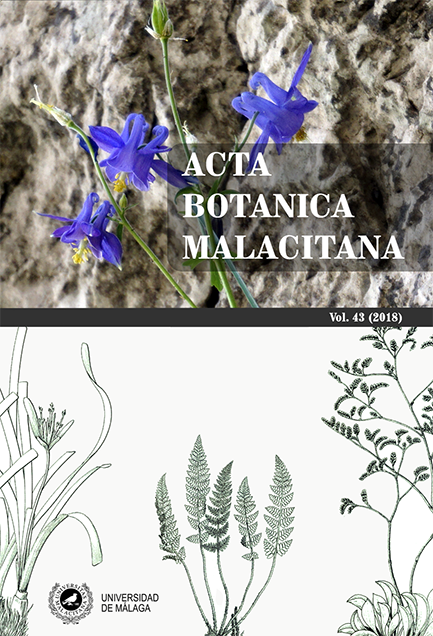Eremopyrum (Ledeb.) Jaub. & Spach, a new genre for the Flora of western Europe (Iberian Peninsula)
DOI:
https://doi.org/10.24310/abm.v43i0.3798Abstract
Se cita por primera vez en la Península Ibérica y en Europa Occidental la presencia de Eremopyrum orientale (L.) Jaub. & Spach, un taxon anual que se desarrolla en los medios semiáridos de la Hoya de Guadix (Granada). Las características ambientales propias de estos ambientes (sustratos poco favorables para el desarrollo de la vida vegetal junto a una alta irregularidad intra e inter anual de las precipitaciones) parecen ser la causa de no haber sido localizada hasta ahora. Esas mismas características ambientales y la, aparentemente imparable, expansión de las actividades antropocéntricas nos hacen considerar este taxon como amenazado bajo la categoría de En Peligro (EN) con el criterio: A4ac; B1ac(i,ii,iii,iv)+2ac(i,ii,iii,iv)
Key words: Flora, Europa, Poaceae, Eremopyrum.
Palabras clave: Flora, Europa, Poaceae, Eremopyrum.
Downloads
Metrics
References
Anthos (2017). Sistema de información de las plantas de España. Real Jardín Botánico, CSIC-Fundación Biodiversidad. Published on the Internet.www.anthos.es [accessed 2 May 2017]
Bentham, G. & Hooker, J. D. (1883). Genera Plantarum3. London: Williams & Norgate.
Blanca, G., Cabezudo, B., Cueto, M., Salazar, C. &Morales Torres, C. (Eds.) (2011). Flora Vascular de Andalucía Oriental, 2nd edition. Universidades de Almería, Granada, Jaén y Málaga, Granada, 1751 pp.
Cabi, E. & Dogan, M. (2010). Taxonomic study onthe genus Eremopyrum (Ledeb.) Jaub. et Spach (Poaceae) in Turkey. Plant Systematics and Evolution287, 129-140. https://doi.org/10.1007/s00606-010-0306-1
Clayton, W. D. & Renvoize, S. A. (1986). Genera Gramineum. Grasses of the World. Kew Bulletin Additional Series 13, 1-389
Doue (2013). Directiva 2013/17/UE del Consejo de 13 de mayo de 2013 por la que se adaptan determinadas directivas en el ámbito del medio ambiente, con motivo de la adhesión de la República de Croacia. Diario Oficial de la Unión Europea, 560, 193-229
Frederiksen, S. (1991). Taxonomic studies in Eremopyrum (Poaceae). Nordic Journal of Botany 11,271-285.
Ibn Tattou, M. (2014). 989. Eremopyrum (Ledeb.) Jaub. & Spach. In M. Fennane, M. Ibn Tattou & J. El Oualidi, Flore Practique du Maroc vol. 3 (pp. 626-627). Rabat: Cana Print.
IUCN (2012). IUCN Red List Categories and Criteria: Version 3.1. IUCN Species Survival Commission, Gland, Switzerland and Cambridge, UK.
IUCN (2017) Guidelines for Using the IUCN Red List Categories and Criteria: Version 13. Standards and Petitions Subcomitee. Gland, Switzerland and Cambridge, UK.
Jaubert, C. & Spach, E. (1851). Gramineae Orientales Novae vel Criticae. Annales des Sciences Naturelles. Troisième Série. Botanique. Tome Quatorzieme, 351-366.
Ledebour, C. F. (1829). Flora Altaica. Tomus I (Classis I-V), 113.
Löve, A (1984). Conspectus of the Triticeae. Feddes Repertorium 95, 425-521.
Marchal, F. M., Lendínez, M. L., García Fuentes, A. & Torres, J. A. (2011). Yesos del Guadiana Menor. In J. F. Mota, P. Sánchez-Gómez & J. S. Guirado (Eds.). Diversidad vegetal de las yeseras ibéricas. El reto de los archipiélagos edáficos para la biología de la conservación (pp. 481–484). Almería, España: ADIF-Mediterráneo Asesores Consultores.
Melderis, A. (1980). 50. Eremopyrum (Ledeb.) Jaub. & Spach. In T. G. Tutin, V. H. Heywood, N. A. Burges, D. M. Moore, D. H. Valentine, S. M. Walters & D. A. Webb (Eds.), Flora Europaea V. (pp. 200). Cambridge: Cambridge University Press.
Nevsky, S. A. (1936). Conspectus Loliearum, Nardearum, Lepturearum. Hordeearunquem Florae Unionis Rerum Publicarum Sovieticarum Socialisticarum. Trudy Botani Eeskogo instituta Akademii nauk SSSR. Ser. I. Flora i sistematika vyssih rastenij 2: 33-90.
Sakamoto, S. (1979). Genetic relationships among four species of the genus Eremopyrum in the tribe Triticeae, Gramineae. Memoirs of the College of Agriculture, Kyoto University 114, 1-27.
Schulz-Schaeffer, J. & Jurasits, P. (1962). Biosystematic investigation in the genus Agropyrum. I. Cytological studies of species karyotypes. American Journal of Botany 49, 940-953.
The Plant List (2013). Version 1.1. Published on the Internet; http://www.theplantlist.org/2 (accessed 5 May 2017).
Tournefort, J. P. (1703). Corollarium institutionum rei herbariae, in quo plantae 1356 munificentia Ludovici Magni in Orientalibus regionibus observatae recensentur. París: Typographia Regia.
Tzvelev, N. N. (1976). Tribe 3. Triticeae Dumort. Poaceae URSS. Leningrad: Academia Scientiarum URSS.
Valdés, B. & Scholz, H.; with contributions from Raab-Straube, E. von & Parolly, G. (2009). Poaceae (pro parte majore). Euro+Med Plantbase.
Downloads
Published
How to Cite
Issue
Section
License
All information related to the licensing of published works in Acta Botanica Malacitana and copyright can be found in our Editorial Policy.







1.png)
